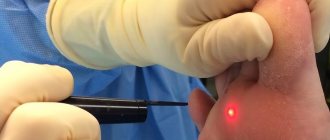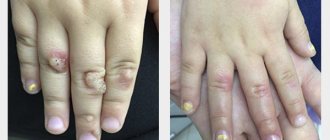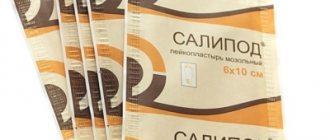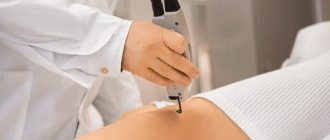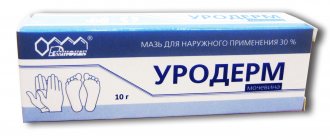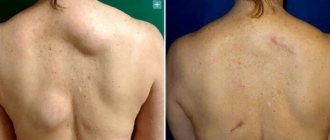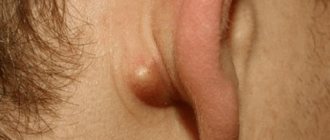When treating a callus, the wound must be cared for more carefully: treat it with the means recommended by the doctor (healing ointments, antiseptic) and bandage it for 7 to 10 days.
At this time, you need to limit the pressure on the treated area. If laser removal of calluses on the toes has been performed, the patient should try to wear comfortable shoes. In this case, the orthopedic option is optional. However, it is better to choose only those manufacturers who take into account all medical standards in their products. Such shoes should be well ventilated.
During the rehabilitation period, patients can use special rings or gel pads. They are needed so that the treated area does not come into contact with anything. Doctors also do not recommend visiting the pool, sauna or bathhouse at this time.
Complete healing after hardware treatment depends on the size and depth of the wound and can occur after 21 days.
Advantages and disadvantages of laser callus removal
This treatment is effective because it allows you to get rid of even the deepest calluses. At the same time, an excellent result, as a rule, can be achieved after just 1 procedure, which lasts only 10 minutes. Other benefits:
- It is painless thanks to local anesthesia.
- There are no scars left on the skin after the laser.
- Hardware removal of calluses is called one of the safest procedures. During this procedure, the doctor works without contact, and the device disinfects the surface being treated.
- The rehabilitation period after laser removal of dry calluses takes place without hospitalization. It doesn't take much time.
The laser technique has many advantages, but patients also highlight several disadvantages. Among them are the high prices for this procedure. During the rehabilitation period, the treatment area requires, although not complicated, daily care.
Reasons for appearance
Corns appear as a result of hyperkeratosis. The stratum corneum of the epidermis thickens due to constant friction or pressure. Later, a rod appears under the layer of dead skin cells. It is this that causes discomfort and pain. Removing calluses at home does not give results, because it is impossible to get rid of the hard core on your own. A callus looks like a grayish or yellow stratum corneum with a depression in the center.
Is it dangerous?
Corns are harmless, but they still need to be removed. There are several reasons to get rid of the growth:
- it causes pain and interferes with walking;
- over time the growth becomes larger;
- the formation can crack, bleed, and become inflamed.
Possible complications and contraindications
Calluses are not removed with a laser if the doctor determines that the patient has an infectious disease. You cannot use light radiation on tissues with pathology if the diagnosis includes:
- oncology;
- epilepsy;
- diabetes mellitus in decompensated form;
- herpes in the treatment area.
Laser treatment is contraindicated during pregnancy and breastfeeding.
The child's tumors are removed only if there is severe pain. To do this, you need the written consent of the parents and the presence of one of them at the procedure. However, doctors recommend, if possible, such treatment from the age of 16.
External and internal causes of callus growth
The most common external source of problems is shoes. It may turn out to be:
- not adjusted to human anatomical standards;
- too small, tight, or with seams protruding inward;
- made from non-ecological materials.
The last point implies the formation inside the shoes of an ideal environment for the proliferation of pathogenic microorganisms. The feet cannot “breathe”, which provokes not only an unpleasant odor, but also painful skin pathologies.
Sometimes the problem is caused by a pair that is too big. Particular care should be taken in selecting specimens for those who already have some problems with the anatomical structure of the lower limb. Only a clinic with a practicing orthopedist will help here.
But giving up shoes completely is also a bad option. Dropsy, which degenerates into calluses, also occurs due to prolonged walking barefoot on a hard surface. If we add to this increased sweating and forgotten rules of personal hygiene, then all the risks of developing skin growths are obvious.
Before sending the patient for laser excision, the specialist will definitely find the cause of the formation of defects. The reasons for their occurrence can be both external and internal factors. In the most advanced clinical situations, several aspects are mixed, which aggravates the situation, prolonging the course of therapy.
Among the most popular internal causes are diseases of fungal or viral origin. That is why it is so important to first make sure that a person does not suffer from such an ailment, and then get rid of the aesthetic defect.
The first potential provocateur is diabetes mellitus. No less often, patients suffering from calluses are also diagnosed with psoriasis, kerotodermatosis, and ichthyosis.
Even flat feet increase the chances of encountering unattractive, rough patches of skin. To successfully treat the disease and simultaneously neutralize growths, you should consult a dermatologist.
Cost of laser callus removal
The cost of therapy depends on the diameter of the pathology. At the medical center they can perform laser removal of calluses at the price:
- about 400 rub. on an area up to 1 mm2;
- 600 rub. – 2 mm2;
- 1000 rub. – 3 mm2.
Each subsequent millimeter will increase the total amount by 400 rubles. As a result, the price of laser callus removal on an area of 10 mm2 will be 3,800 rubles.
Some medical centers indicate the complexity of the procedure in their price list. Patients will pay on average:
- for category 1 – from 2000 to 2500 rubles;
- for category 2 – from 2500 to 3500 rubles;
- for category 3 – from 3500 to 7800 rubles;
- for category 4 – from 5,000 to 8,000 rubles.
Laser removal of core calluses will be more expensive than the treatment of conventional growths.
Advantages of SM-Clinic
Our medical center employs some of the best specialists in St. Petersburg. The latest equipment is used to conduct research and any interventions. We have our own laboratory. With us you can undergo an examination and take the necessary tests quickly, comfortably, and without queues. Recovery after the procedure takes place within one day. The clinic has a hospital with comfortable rooms where patients are accommodated if necessary. You can make an appointment by phone or online.
Reviews from patients and opinions of specialists
Doctors call laser therapy the safest method. It is much less traumatic than, for example, surgical intervention (excision), but it still gives a good result. Experts recommend not to self-medicate, but to immediately seek qualified advice.
In reviews of the removal of calluses on the feet with a laser, patients note the effectiveness of the method, because it helps to cope even with old pathologies. The healing time of wounds after the procedure largely depends on the size of the treated surface. In some patients, the crusts disappear within 2 weeks; in others, complete recovery lasts for 2 months.
The complaints that are written about in negative reviews include wounds healing too slowly and the inability to step on the foot for a long time. The reason may be a violation of treatment technology or non-compliance with recommendations.
Laser removal of calluses gives good results. At the same time, it does not require special preparation. The procedure lasts no more than 10 minutes and is painless with local anesthesia.
Types of calluses
Content:
- Types of calluses
- External and internal causes of callus growth
- Features of laser removal
- Indications and contraindications
Regardless of what type of skin roughness affected the victim, the reasons for their formation remain the same factors. Often we are talking about prolonged and regular friction and compression of the skin area when wearing shoes that are not adapted to the anatomical characteristics of a person.
The most common type of callus is the water or wet variety. It is so called because it looks like a bubble filled with liquid. Lymph collects under the thin, almost transparent skin. Such sacs with biological fluid can reach impressive sizes, appear in groups and then merge into a single whole.
Some ordinary people try to fight them using an accelerated program - cutting, squeezing or piercing the contents. This does not lead to anything good, but only increases the risk of developing an infectious lesion. This is confirmed by numerous reviews from victims of their own lack of foresight.
The second most common type of skin growth is the so-called dry callus. This is a direct consequence of unqualifiedly treated or excised dropsy - a formation of the first category. A roughness is formed after the bubble bursts or it is pierced with a needle. The remaining skin grows to the bottom of the wet callus, forming a dense new layer.
Over time, the area of dead tissue will increase, which will add dry calluses or expand the lesion. Externally, this pathology is characterized by a dense skin growth, a small lump that initially does not hurt even with pressure, and a yellowish color.
If this was found on the legs between the toes, or on the foot, then this is a reason to immediately make an appointment with a dermatologist. Trying to pick out the seal yourself is strictly prohibited, as the risks of introducing pathogens are too great.
Adding to the problem is the fact that not all people far from medicine are able to correctly distinguish the still relatively harmless classic dry callus from the core version. This is the final stage of degeneration of the keratinized skin area. The main feature of this pathology is penetration into the deeper layers of the skin. When trying to cut off the upper part of the growth, the patient, in the most successful scenario, will only get rid of the cap. The root, which affects the cells to a depth of several centimeters, will remain inside.
The rod can only be dealt with by radical methods, the most optimal of which was the use of laser equipment. Thanks to a precise, almost “jewelry” effect on the lesion, the doctor will be able to excise the skin tubercle along with the extensive root system.
No other method provides such high results, since with the help of a laser it is possible to reach even a long root. If at least the fate of the branched system remains inside, then in the future it will come back to haunt the same place. Because of this, traditional surgical intervention cannot boast of increased productivity.
A strongly ingrown root first provokes damage to the nerve endings. Over time, its effect on surrounding tissues becomes even stronger, because instead of unpleasant sensations, the patient will experience unabated pain. Cleaning with a pumice stone or going to a pedicurist to superficially scratch off a specific corn will only bring partial relief.
The price of laser services varies depending on the area of the lesion, the depth of root germination, and the type of specific callus. Also, the cost may be affected by the inclusion of an auxiliary stage such as additional examinations.
You should not refuse the recommendation to undergo tests, since the dermatologist must first understand the true cause of the disease. A particularly relevant decision to undergo clinical trials will be for those victims who constantly face similar problems on their toes.
The growths make themselves felt in different places, causing inconvenience. If this happens, then this indicates internal malfunctions in the body. Not a single super-powerful laser will help prevent relapses in this situation unless treatment is started from the inside.
The doctor will be able to accurately answer the question of how much the procedure costs only after calculating the need to use local anesthesia. Regardless of what type of pain relief medication is chosen, a real pro will first conduct a preliminary allergy test. This will avoid the possible onset of anaphylactic shock.
Which treatment is most effective?
Pharmacy drugs
How to cure calluses with drugs from the pharmacy? Professional medical methods include the use of the following:
- plasters. Their inner surface is impregnated with special medicinal substances.
They soften and exfoliate keratinized areas. Ointments. They act on the problem more dynamically and do not require constant influence.
The ointment must be applied to the skin between the fingers, then apply a bandage and secure. After the procedure, after some time, the rough skin comes off easily with the help of a pumice stone or a washcloth.
The most popular and effective pharmaceutical drugs today are:
Before using a particular pharmaceutical drug, you should carefully study the instructions for use! This is required in order to determine the type of callus for which it is intended.
Folk remedies
Alternative medicine offers many recipes for preparing medicines that will help remove interdigital tumors.
There are a large number of types of influence.
Compresses
To carry out these procedures, natural ingredients are used, which should be crushed to a mushy state.
The most effective components for compresses are:
- baked garlic;
- lemon;
- celandine;
- raw potatoes;
- aloe;
- figs;
- prunes;
- Castor oil.
To carry out the procedure, you need to steam your feet well. Place the paste on a small piece of gauze. If the ingredient is too liquid, you should soak the fabric with it.
Apply gauze to the affected skin surface, secure with a bandage or plaster, or put on a sock. The compress is best done before going to bed.
How to treat interdigital callus
At the initial stages, it is enough to choose comfortable shoes and use a silicone interdigital insert.
Most often, patients come in when secondary inflammation occurs. In this case, the keratinized area must be carefully removed. Exactly carefully, without damaging the underlying skin. A radio wave scalpel or CO2 laser is suitable for this.
Here, too, after purulent inflammation. The girl has noticeable signs of transverse flatfoot: valgus deviation of the big toe and a characteristic intersection of the 1st and 2nd fingers (like a “crossbill’s beak”)
But this is not the most important thing. The main thing in treatment is to minimize the root cause: the pressure of one finger on another. During the dressing period, a roller is formed and placed in the fourth interdigital space. After the wound has healed, it is recommended to wear a silicone interdigital insert and select shoes.
In severe recurrent cases, orthopedic surgery is used
Resection of the base of the proximal phalanx of the 4th toe. The protruding part of the bone, which leads to pathological pressure on the interdigital space, is removed.
Syndactylization This is an operative method used in very severe, recurrent cases. An area of skin in the interdigital space is excised and the fingers are actually stitched together. Functionally, the foot does not suffer. Syndactylicity is usually combined with lateral resection of the head of the metatarsophalangeal joint. When suturing, it is very important to fix the little finger at the same level as the adjacent finger. Not higher and not lower.
Localization of growths on the legs
Localization of the tumor is usually caused by wearing uncomfortable shoes. In most cases these are flip-flops. Most often, internal calluses develop between the big and second toes. They are difficult to treat. Therefore, to remove them, it is better to contact specialists. They will use methods that are safe from a professional point of view.
If a callus appears between the 4th finger and the little finger, then this is a big problem for women. Because growths in this place cause excruciating pain when wearing high-heeled shoes. Since the fourth finger squeezes the little finger, which significantly aggravates the condition.
To eliminate tumors between the fingers in such cases, you need to contact a dermatologist or cosmetologist. They will remove calluses using drilling or laser treatment.
Photo of a neoplasm with a rod
How to remove the growth?
This neoplasm is a skin compaction that has a deep core. Core calluses (also called ingrown calluses) appear in people quite often, but getting rid of them is extremely difficult.
To do this, you should contact specialists.
A tumor with a rod can be removed by professionals in the following ways:
- drilling. Hardware manicure involves removing dead skin. As for core calluses, to remove them there is a special attachment with which the growth is sawed off. But to carry out such a procedure, you should contact a qualified specialist. Because there is a risk of skin damage when the nozzle goes too deep. Also, if the sawing is insufficient, part of the rod may remain. This will lead to the re-development of the rod growth.
- Laser removal. This is an expensive method of removing growths, so it is used in rare cases. Laser exposure completely burns the dead skin along with the shaft. The possibility of the problem reoccurring after the procedure is excluded.
- Cryotherapy. This method involves influencing the interdigital neoplasm using low temperatures. Liquid nitrogen completely destroys the callus along with the stem, which eliminates the possibility of relapse.
Ignoring core skin compaction
Untimely treatment or its absence in the presence of rod growths can lead to dangerous consequences.
As a person develops, the following unpleasant changes may occur:
- microcracks;
- infection in the formed wounds;
- development of the inflammatory process.
Inflammation of the callus can lead to suppuration. Neoplasms with pus require treatment in a hospital setting to completely eliminate them.
Prices
Price (rub.)In installments* (rub.)Excision/removal of benign formations of the skin and mucous membrane, category I. complexity 2550—Excision/removal of benign formations of the skin and mucous membrane, category II. complexity 4050—Excision/removal of benign formations of the skin and mucous membrane, category III. complexity7800—Excision/removal of benign formations of the skin and mucous membrane in a generalized process (1 zone)19500—* You can read more about the conditions here - Treatment on credit or in installments
The cost is preliminary. The exact cost of the operation can only be determined by a surgeon during a free consultation.
What recommendations are important for a patient to follow after cryodestruction of a callus?
After removing the callus with nitrogen, it is important to:
- limit the pressure on the site of destruction by reducing the load (walking, playing sports, wearing high heels, tight shoes, etc.);
- do not injure, rub or scratch the frozen area;
- Maintain foot skin hygiene: wash your feet daily with soap, then dry them with a clean towel, change your socks.
To prevent recurrence of callus formation, it is necessary to eliminate possible causative factors:
- wearing tight or narrow shoes;
- use of shoes with or without high heels.
It is also important to promptly treat lesions of the osteoarticular system to prevent further joint deformation, and for overweight patients to reduce it. Doctors recommend using orthopedic pads to reduce the likelihood of relapses of calluses, and timely pedicures to eliminate local thickening of the skin of the sole.
Contraindications for cryodestruction of calluses
Contraindications to the use of liquid nitrogen for the destruction of calluses are:
- Cold intolerance - manifested by the formation of an itchy rash on the skin when exposed to low temperatures (in the cold, when exposed to cold water, when applying an ice cube).
- The presence of allergic rashes, pustular elements or a violation of the integrity of the skin in the area of expected exposure. To use cryodestruction in this case, preliminary treatment of existing rashes is required.
- Insufficiency of arterial circulation in the feet against the background of obliterating atherosclerosis, complications of diabetes mellitus.
- The presence of cryoglobulinemia is a rare disease in which special proteins are formed in the blood (cryoglobulins) at temperatures below 37°C. This condition accompanies various vasculitis - vascular inflammation, Raynaud's syndrome, viral hepatitis C, etc.
